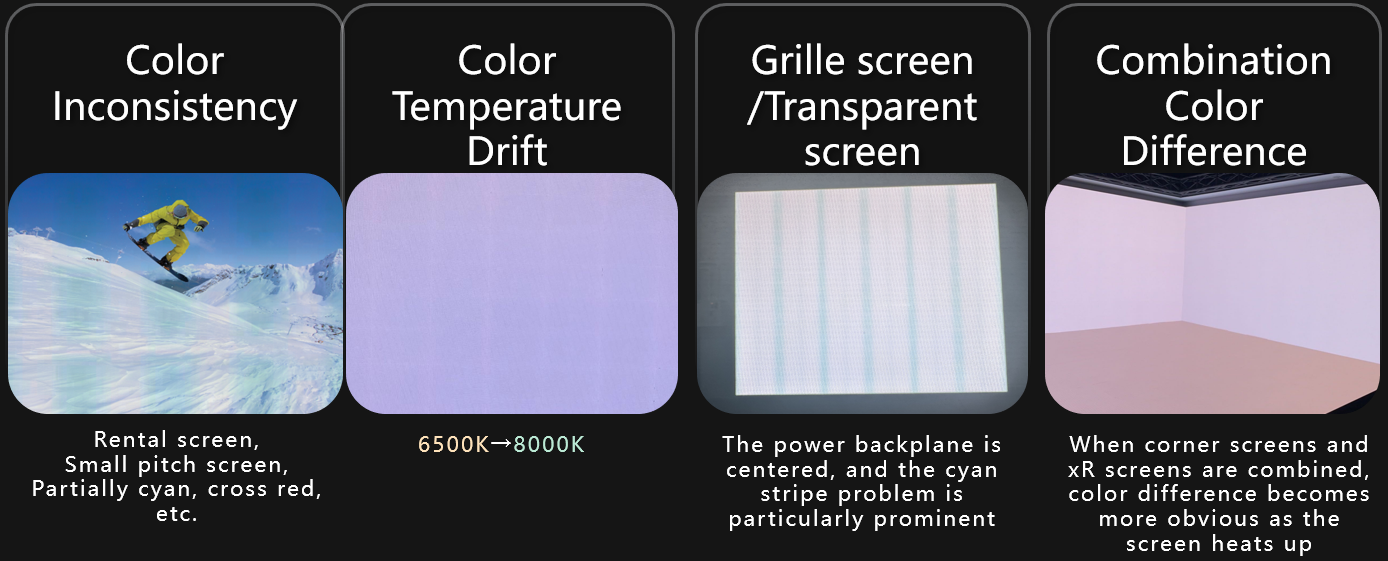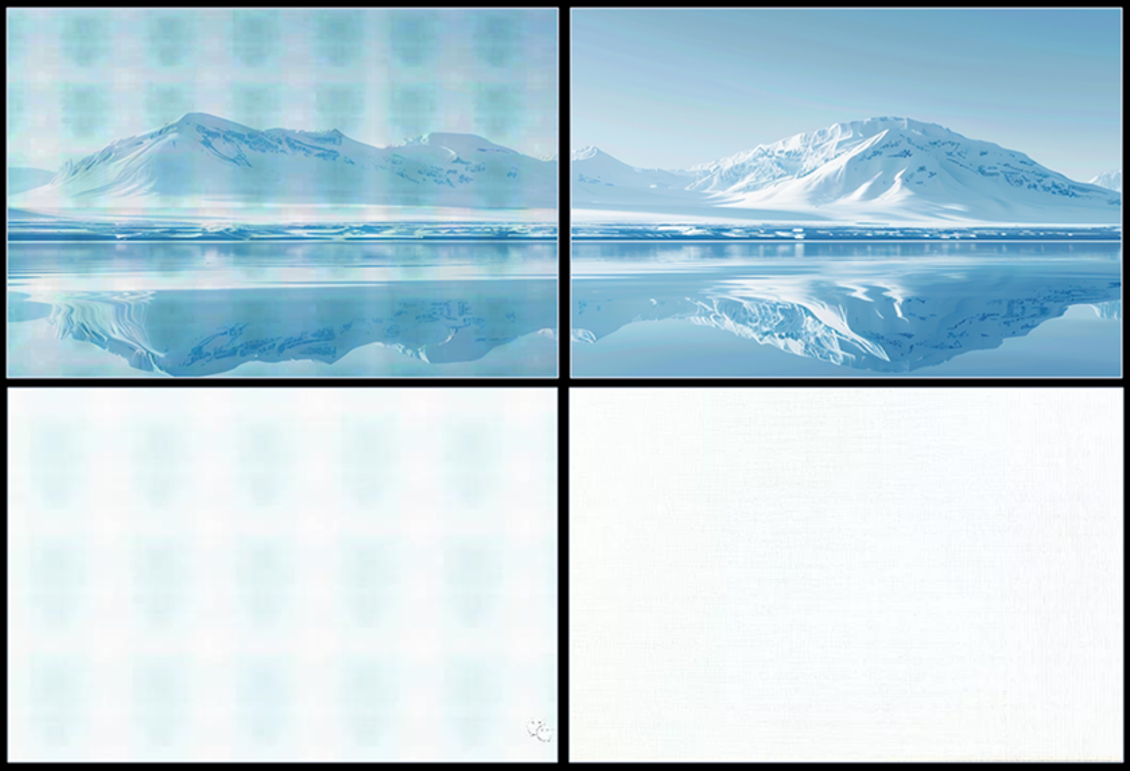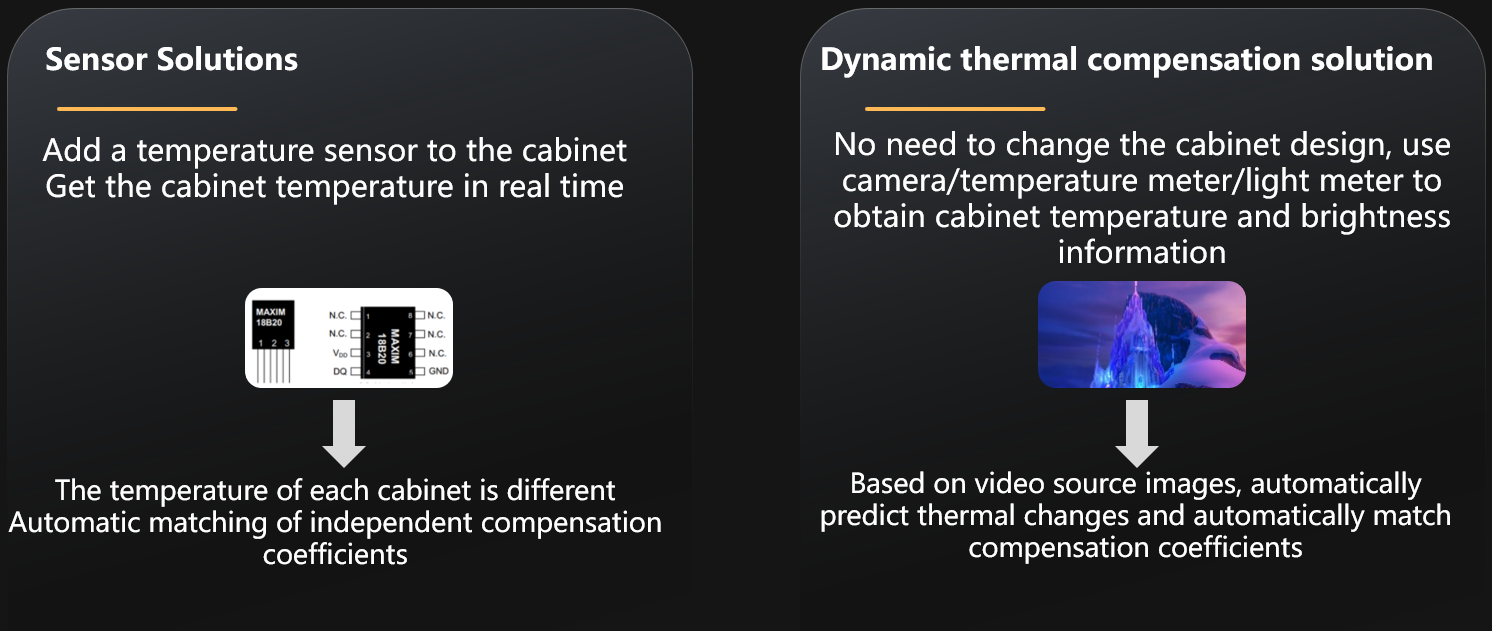¶ Thermal Phenomenon
Long-term operation of the screen will cause uneven screen temperature and thermal effect issues

Root Cause: Characteristics of Lamp Beads + Uneven Heat Distribution

¶ Adaptive Thermal Compensation
We released Industry's first Adaptive thermal compensation technology, as the demo, see the figure. The left part and right part have a big difference, by enabling this function, the technology can even the color difference by Dynamic thermal compensation coefficient, so users are no longer worried about LED screen temperature growing, this tech can promise screens have different compensate for different color performance.

Adaptive Thermal Compensation is the industry's first technology route, which can effectively solve the color temperature shift problem of LED screens after heating without affecting the display effect of the screen itself. The proprietary thermal compensation algorithm can also ensure that the screen brightness does not significantly decrease, which is a technological innovation that leads the entire industry. It can meet the following technical specifications at the same time:
- Color temperature shift <100K: Strictly control the range of color temperature change to ensure that the screen color is always natural and provides viewers with a comfortable viewing experience.
- Color coordinate shift <0.01: Accurate color reproduction, eliminating any visible color deviation, to meet the needs of professional-level applications.
- Brightness loss <5%: In substantial temperature changes, the screen brightness only fluctuates slightly, with almost no impact on the visual experience.
There are two ways to implement this technology. One is to install a temperature sensor on the LED module. The sensor can sense the actual temperature of the LED module and adjust the heat compensation coefficient in real time to solve the thermal issue. The second technology does not rely on sensors. Our engineers use professional temperature testing instruments on site to record the process of the screen from cold to hot. Each degree has its own corresponding coefficient. During the detection process of the receiving card, the dynamic real-time compensation coefficient is used to solve the thermal issue.

¶ Sensor Solution Introduction
- Add a temperature sensor to the cabinet, and get the cabinet temperature in real time
- Prepare 3x3 cabinets, perform thermal calibration, and generate thermal compensation coefficients
- Upload the coefficients to all cabinets in the same batch
- The sensor returns the temperature, and the system automatically matches the compensation coefficient based on the temperature.
¶ Device Requirement
- Sending card: COEX series
- Receiving card: A10s Pro, CA50E, XA50 Pro
¶ Calibration Requirement
- Screen: 3x3 cabinets
- Camera: C3200
- Colorimeter: CA410 (brightness > 5000nit, use CA-P427H)
- Temperature probe: Optris infrared temperature sensor_OPTCSLT15SFCB1 is recommended
- Accessories: Neutral filter
- Software and hardware version: Please Contact the Sales Engineer
¶ Advantages of the Solution
- The cabinet temperature of the large screen may be different in different working environments or positions of the large screen. Each cabinet has an independent compensation coefficient, which has a better effect.
- The cabinet temperature is transmitted back in real-time, and the compensation effect is automatically adjusted in real-time.
¶ Dynamic Thermal Compensation Solution Introduction
- Prepare 3x3 cabinets and use a camera + temperature meter + light meter to collect screen temperature and brightness information
- Generate thermal compensation coefficient and upload to NCP
- Upload the coefficients to all cabinets in the same batch
- The thermal algorithm combines the usage of the screen to predict the thermal change rules and output-matching compensation coefficients
¶ Device Requirement
- Sending card: COEX series
- Receiving card: A10s Pro, CA50E, XA50 Pro
¶ Calibration Requirement
- Screen: 3x3 cabinets
- Camera: C3200
- Colorimeter: CA410 is recommended (brightness > 5000nit, use CA-P427H)
- Temperature probe: Optris infrared temperature sensor_OPTCSLT15SFCB1 is recommended
- Accessories: Neutral filter
- Software and hardware version: Please Contact the Sales Engineer
¶ Solution Comparison

¶ Advantages of Adaptive Thermal Compensation Solution
1. Industry-leading effects
High-brightness screens such as transparent screens, grille screens, and rental screens have remarkable effects.
2. Adaptive compensation
The screen has a variety of usage environments. End users only need to turn on the function switch to get dynamic adaptive compensation.
3. High calibration efficiency
Only 9 cabinets need to be collected, which can be applied to all screens in the same batch. The calibration time is less than 90 minutes
4. Taking into account brightness and color temperature
- Color temperature shift <100K
- Color coordinate shift <0.01
- Brightness loss <5%
We consistently enhance and refine the content of our Wiki articles.
If you find any mistakes or errors, please contact us.
Your continuous feedback and support will help us further improve our products and content.